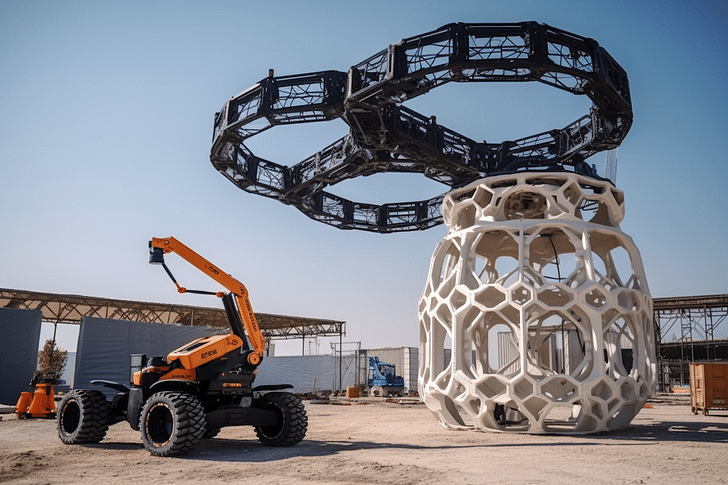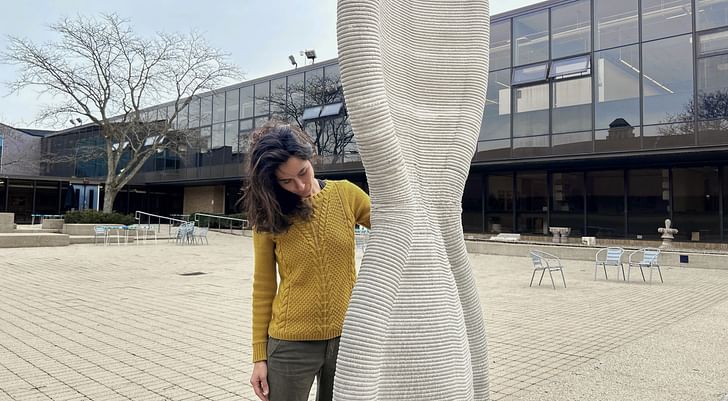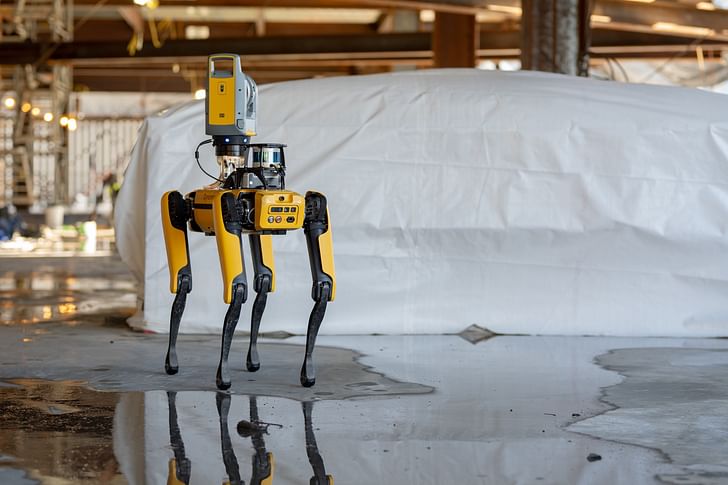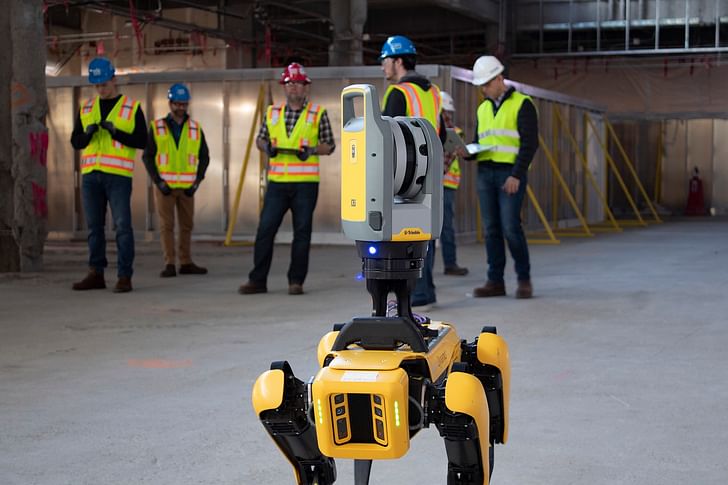

What is the current relationship between humans, robotics, and construction? What is its future? To explore these questions in depth, Archinect speaks with both Boston Dynamics and the Applied Research + Development group at Foster + Partners for their experiences and perspectives in designing, building, and applying the latest innovations in robotics on construction sites.
This article is part of the Archinect In-Depth: Artificial Intelligence series.
Along a growing suburban street outside New York City, two residential schemes are under construction on adjacent plots. On one site, a family of robotic 3D printing arms steadily builds layer after layer of a curving, honeycomb-like facade. Next door, autonomous cranes stand over a semi-completed prefabricated modular apartment building.
Throughout the 3D printed building site, a gentle hum is emitted by the movement of the 3D printing robotic arms and autonomous drones flying above them. In this human-free environment, the drones are the eyes and ears of the operation, live streaming imagery to the contractor’s command facility in San Francisco for a human supervisor to occasionally monitor alongside dozens of other active sites. The drone’s live stream function is somewhat of an add-on. Instead, the primary role of the drone is to collect daily 3D scans of the site on its continuous, preprogrammed route; data which is then sent to the California command center, where a series of AI programs compare the realized output to the architect’s BIM model and archive each day’s progress for future reference. Likewise, the remote human supervisor’s role is a failsafe. Months before construction ever began, generative AI design models were communicating back and forth with the software powering the 3D printing robotic arms, sculpting a design proposal that met all brief requirements and could be delivered on time and on budget without third-party human intervention.

On the site next door, all is not well. In contrast to the gentle hum from the adjacent plot, the prefabricated modular construction site is awash with frantic activity. The night before, after the site had been ‘powered down’ for the evening, hackers had inexplicably taken control of the contractor’s fleet of autonomous construction bots, directing them to demolish freshly-installed structural connections between the modular apartment units. The disruption only lasted five minutes before the contractor’s security system detected the unusual behavior and triggered an emergency shutdown of the site, but that’s all it took to cause days' worth of setbacks.
Fast forward to the morning, and an amalgamation of architects, contractors, project managers, and law enforcement are on the scene while four-legged robots scurry throughout the site, analyzing the full extent of the damage. Although the incident only occurred hours before, the design team has already been provided with a series of options to minimize delays. AI-driven project management software had already analyzed global supply chains, subcontractor availability, and viable production sequences to produce a variety of construction programs that accounted for the need to repair the damaged structural connections. The only remaining dispute among the team was whether the client needed to be made aware of the mishap at all.
Across the street from the commotion, an elderly man is walking his granddaughter to school. The grandfather stops and motions for the young girl to remove her earphones. “I used to do that job,” the grandfather said to the girl, pointing towards the 3D printing construction site. The girl looked up at the drones, bemused. How could Grandpa possibly fit inside a drone? She looked down towards the 3D printing robotic arms. This made even less sense. Studying her grandfather’s hands, she giggled at the thought of concrete shooting from his fingertips before putting her earphones back on and pressing play. “Grandpa’s really losing it,” she concluded.

It’s an intriguing thought experiment; the prospect of a generation of children to whom manual, human construction workers are an alien idea. Throughout the previous century, our story would have found an audience among science fiction writers but few others. Today, the paradigm has shifted. On the topic of autonomous construction, once dismissive talk of technological limitations is gradually being supplanted by more pragmatic conversations over economy, labor, and adoption. Grandpa’s construction job isn’t doomed. As we will see later, the concept of a human-free construction process is far from fruition or desire. However, the premise behind the discussion represents a remarkable shift. Today, the question of how artificial intelligence can intersect with the construction industry is the preoccupation of an expansive field of companies, from startups to manufacturing giants, which make up the approximately $500 million ‘AI in Construction’ market size. One report published at the beginning of 2023 predicts that by 2031, this market will surpass $8 billion.
Throughout the previous century, our story would have found an audience among science fiction writers but few others. Today, the paradigm has shifted.
Our opening story offers clues into where such innovations are taking place. In our scenario, 3D printing robotic arms worked in tandem with computational models to determine how a proposed structure could be most efficiently delivered. In reality, University of Michigan researchers have designed and prototyped a 3D printed, ultra-lightweight structure using this same method.
In our scenario, autonomous drones routinely scanned construction sites, collecting data to be converted into an ever-evolving record of BIM models and visual feeds for remote inspection. In reality, drone manufacturing giant DJI openly markets the ability of its products to generate 3D point clouds of construction sites to help craft a digital model, while U.S. autonomous drone startup Skydio is working with contractors to deploy its products on the construction site.
In our scenario, AI-driven construction management software is infused with all aspects of scheduling, data analytics, and risk management. In reality, the AI construction market is becoming saturated with companies offering similar services, including construction management software giant Procore whose products use machine learning to perform estimates, capture defects, identify risks to construction workers, and improve forecasting through historical analyses.

Our scenario’s most alien proposition is of land-based, agile, autonomous robots performing the analytic and constructive tasks which in the present day are performed by humans, or at the very least, by machines directly controlled by humans. On this question, no company has captured the public imagination like Boston Dynamics. Born out of MIT in 1992, and now owned by Hyundai, the company describes its mission as creating a future in which humans and machines work together to improve safety, productivity, and quality of life. For Brian Ringley, Boston Dynamics’ Principal Product Manager, the operative word for achieving this mission on the construction site is not ‘replacement’ but ‘collaboration.’
“Anyone who is worried about robots being overly disruptive to humans, or completely replacing them, either hasn’t been on a construction site or seriously undervalues human capability,” Ringley told me in a recent conversation. “Whether on the topic of intelligence, dexterity, or communication, working with even the most advanced robots in the world gives you a profound appreciation for what humans are capable of.”
Ringley’s description of the collaborative relationship between humans and robotics isn’t confined to literal hand-in-hand exercises. He cites examples such as the UK construction giant BAM, where human workers from the company’s London headquarters supervised and directed autonomous robots on a site in the remote Shetlands Islands far off the north coast of Scotland. In another context, he cites the ability of human construction workers to deploy robotic agents on tasks with a frequency or complexity beyond human feasibility.
Anyone who is worried about robots being overly disruptive to humans, or completely replacing them, either hasn’t been on a construction site or seriously undervalues human capability. — Brian Ringley, Boston Dynamics
“We have found that teams benefit from constant data capture, but the truth is, nobody can afford to do as much data capture as they would like to,” Ringley explained. “If you can deploy robotics on data capture missions, you are capturing value that simply wasn’t possible to capture before. There is still a human in the loop directing the robot’s path, managing what the nature of the data is, and setting up workflows to consume that data, but with the aid of robotics, they can now continuously monitor construction progress.”
“It is difficult to find any BIM expert who believes they are fully leveraging the value of data-rich models,” Ringley continued. “Imagine if that model wasn’t just a design intent tool but was now a feedback loop tool. The model is always up-to-date with the physical reality of the site, which is invariably different from the original design model. If we could consistently and reliably capture data this way, it takes us to a whole new world of methodologies, software, and professionalization. Valuable human labor would be shifted from rote data capture and job site documentation tasks to model and system coordination. In effect, there are all sorts of avenues that could be opened up if you could trust that a model was accurate at all times. You could use that model to drive other types of automation or other types of robots. You could also more cost-effectively hand over a final ‘as-built’ model to the building owner for use throughout the rest of the building’s lifecycle. You can start to think about phases solely beyond construction.”

Ringley’s description of a collaborative relationship between construction AI and humans is not unique to Boston Dynamics. What sets the company apart from competitors is instead what Ringley labels “athletic intelligence,” in which legged robots move with dexterity and agility designed to mimic those of humans. When Ringley describes athletic intelligence as the “core spirit of the company,” it’s no exaggeration — the Boston Dynamics logo shows a human-like figure in mid-motion.
“You can trace this approach back to the roots of the company, and the mission of how we could bring mobile robots to the world,” Ringley told me when asked about Boston Dynamics’ deliberate pursuit of athletic intelligence. “Wheels can only operate on paved roads, which represents an extremely small fraction of our environment. Humans and animals have evolved with legs. Our approach is a form of co-evolution, which says that if you want to build effective automation for the human-purposed world we live in, you need to include legs. Otherwise, you run the risk of future designers being forced to design environments around automation such as an Amazon warehouse scenario. We take the opposite view: Robotics must be designed for people and for cohabitation.”
Robotics must be designed for people and for cohabitation. — Brian Ringley, Boston Dynamics
Boston Dynamics’ investigations into athletic intelligence can take a variety of forms. In early 2023, a YouTube video of the company’s humanoid robot Atlas lending a hand on a construction site amassed over 6 million views. The video was far from a one-hit-wonder. One year previous, a video of Atlas performing parkour amassed over 14 million views. “Atlas is ultimately a research and development project,” Ringley explained when I asked if Atlas had a commercial future. “The lessons we learn from Atlas will filter into commercial products. Do we think there are future applications in construction for two-handed robotics? Is it necessarily Atlas or even necessarily a humanoid? We have a lot to learn from customers and partners before we figure that out. For now, our videos of Atlas are more of a technology demonstrator.”
While Atlas swings from handlebars, its four-legged companion Spot is leading Boston Dynamics’ commercial product offering to the construction industry. Since its commercial launch in 2020, over one thousand Spot systems have been deployed across the world, with approximately one-third being deployed on construction sites. In our conversation, Ringley lists off a series of use cases for the so-called ‘robot dog’ in the construction industry, many of which are grounded in Spot’s ability to reliably and consistently capture job site data. Prominent examples included capturing data on construction work already completed, identifying deviations from design models, and capturing existing spaces set to undergo adaptation. Spot’s four-legged design is crucial to these missions, enabling the autonomous robot to navigate the often uneven, variable, and obstacle-strewn nature of an active construction site.
You’ll get better results from AI tools if you feed them better quality data. ― Brian Ringley, Boston Dynamics
While conversations on the impact of artificial intelligence in architecture can sometimes become narrow-focused discussions on new-age generative tools, Spot’s operation and use cases are instructive examples of how artificial intelligence can permeate the design and construction process in a variety of forms. Boston Dynamics describes athletic intelligence as a form of AI, offering the robot an inherent sense of balance and perception, allowing it to traverse difficult terrain along preset routes with little or no input from users. Spot’s ability to navigate unpredictable surroundings is not currently grounded in machine learning, although recent reporting suggests this may change. In a separate context, as construction managers increasingly adopt AI systems for tasks such as material quantification, on-site progress, model deviation, clash detection, and safety auditing, the demand for high-quality data spurs much of Spot’s development. “These systems benefit from the frequency of data and repeatability of data across the board,” Ringley told me. “You’ll get better results from AI tools if you feed them better quality data. This is something that Spot is uniquely positioned to do versus other methods of capture on job sites.”

In an analysis of use cases for Spot in the design and construction industry, few companies have as unique a perspective as Foster + Partners. In 2020, the firm became the first architecture practice to take part in the Boston Dynamics’ Early Adopter Program for Spot, deploying the robot in a range of contexts from the Battersea Roof Gardens construction site and Foster + Partners’ own campus in London as it underwent renovation.
“Spot was an example of our interest in investigating disruptive technologies, and of how robotics could be used in the AEC industry to revolutionize the way we work,” Foster + Partners Senior Partner Martha Tsigkari told me in a conversation alongside Partner Adam Davis and Associate Partner Sherif Tarabishy. Tsigkari leads the company's Applied Research + Development (Applied R+D) group; a team of under 20 people, including Davis and Tarabishy, whose remit includes machine learning and robotics but also expands to areas such as performance-driven design optimization, buildability, extended reality, and digital twins. “We usually make up 1% of the company, but we believe in Einstein’s relativity formula of having a small mass but huge acceleration,” Tsigkari explained. “We look at what disruptive technologies exist in the wider world and seek to understand how we can integrate them into the AEC industry at all stages of the design process, from conception to completion.”
Robotics will be good for certain things, and humans will be good for other things. Our interest here is in the human-robot collaboration. — Martha Tsigkari, Foster + Partners
Throughout our discussion, the Applied R+D group aligns with Ringley’s earlier vision for Spot’s predominant role in construction: Consistent autonomous scans to generate data that the team can use to compare as-designed versus as-built models. However, the team’s experience with Spot also opened other use cases. “We were interested in using Spot not just during construction but during building operation,” Davis explained. “In our practice, we are regularly measuring factors such as air quality, lighting, and energy usage to understand changes in space over time. If you have spaces that change regularly, such as breakout areas where furniture is often manipulated, a consistent three-dimensional scan can allow you to understand how we use space.”
While other industrial robots require human partners to be extensively trained in their use, the team sees promise in Spot’s ability to coexist in the office environment without significant human intervention, though it is not without its challenges. “At this stage, and likely for some time to come, it is still a head-turner,” Davis added. “The 'paparazzi' were quite keen to take cameras out and photograph it, and one person ran over to hug it. In a working environment, we will need changes in technology but also changes in culture, whereby we reach a point where people aren’t distracted by the presence of robots.”
The Applied R+D group’s description of their experience with Spot offers tangible examples of what Boston Dynamics' Ringley determined as the varying but collaborative relationship between humans and robotics; one which he hopes will be nurtured on future construction sites.
At the Battersea Roof Gardens site, where Spot was used to perform data capture missions along a consistent route, Tarabishy offers an insight into the human-robotic relationship as it existed in the 2020 edition of Spot. “We would define a route by taking Spot to a starting point and manually driving it through the route we wished to take scans from,” Tarabishy explained. “Each subsequent time, we would place it at the starting point, and tell it to repeat. Initially, if it encountered a permanent obstacle, it would sit down and inform the team it was unable to proceed. As we gave feedback to Boston Dynamics, features were added which gave us options to manually maneuver around the obstacle while still collecting data, or skip the scan and move to the next mission.”
It’s not a question of what robotics can offer, because we see every day that they can offer a lot. It’s more about how we will interact with them. ― Martha Tsigkari, Foster + Partners
“It’s not a competition between humans and robots,” Tsigkari noted as we reflected on the broader theme of robotics in construction. “Robotics will be good for certain things, and humans will be good for other things. Our interest here is in the human-robot collaboration, and how it could work in the AEC space. It’s not a question of what robotics can offer, because we see every day that they can offer a lot. It’s more about how we will interact with them. This is what many people need to come to terms with, and what forms part of our work: To ensure that the relationship between humans and robotics on a construction site or in a building is as seamless as possible.”

Returning to our opening story, in which human construction workers were supplanted by robotics, the experience of Boston Dynamics and Foster + Partners strongly suggests that our fable is just that: A fictitious tale with little probability of manifesting in the foreseeable future. Readers of this article will not find themselves reminiscing on a bygone era of human construction workers as our fictitious grandfather did. The looming fear is nonetheless understandable. In 2023, where reports from economic authorities from the World Economic Forum to Goldman Sachs detail the millions of human jobs which could be replaced by artificial intelligence, there can be a temptation to group robotics, generative tools, AI-powered analytics, and more into a single job-hunting army. In reality, each innovation must be addressed within its own context, and, for now, the landscape of construction robotics holds mountainous obstacles to overcome before a future dominated by entirely robotic construction sites appears on the horizon.
Every construction site presents its own unique context, leaving little room for pre-programmed repetition, and a higher demand for the level of spatial intuition and manipulation that the human mind and body have developed over millions of years.
In robotics circles, perhaps the largest mountain is Moravec’s paradox, which argues that it is significantly more difficult for computation to match humans in sensorimotor and perception skills than in reasoning. “It is comparatively easy to make computers exhibit adult level performance on intelligence tests or playing checkers, and difficult or impossible to give them the skills of a one-year-old when it comes to perception and mobility,” Hans Moravec wrote in 1988. The technological landscape of the 21st century has so far proven Moravec correct, spurred faster still by the relative financial ease at which AI software can embark on a journey of trial and error when compared with robotic hardware. The resulting disparity we perceive between innovations in bits versus atoms was captured by Peter Thiel in his much-quoted remarks at Yale University in 2011. “What happened to the future?” Thiel wondered. “We wanted flying cars, instead we got 140 characters.”
It’s not an exciting vision to say 'robots are here to replace us' ― Brian Ringley, Boston Dynamics
When we look beyond digital arenas such as ChatGPT and social media algorithms and focus our attention exclusively on computational applications in real-world settings, construction sites continue to serve as uniquely difficult environments for robotics to contend with. As Moverac’s paradox suggests, ever-more complex physical environments present ever-increasing challenges for robotics to overcome. In highly-choreographed, predictable, rules-based settings such as vehicle production lines or packaging warehouses, robotics can be programmed to perform repeatable, automated tasks. Construction sites, by contrast, are in a state of constant flux. Every construction site presents its own unique context, leaving little room for pre-programmed repetition and a higher demand for the level of spatial intuition and manipulation that the human mind and body have naturally evolved over millions of years. Here, Ringley’s overall assessment of the comparison between human and robotic capabilities bears repeating: “Working with even the most advanced robots in the world gives you a profound appreciation for what humans are capable of.”
“It’s not an exciting vision to say ‘robots are here to replace us,’” Ringley told me as our conversation concluded. “What’s joyous and interesting to me about this work is that there are tasks that humans and robots can achieve together that far surpasses what machines can do in isolation and what people can do in isolation. Let’s figure out what those things are and design systems to enable them.”
Niall Patrick Walsh is an architect and journalist, living in Belfast, Ireland. He writes feature articles for Archinect and leads the Archinect In-Depth series. He is also a licensed architect in the UK and Ireland, having previously worked at BDP, one of the largest design + ...
1 Comment
Look at the cute, helpful robot dogs! They dance, they do parkour, they do construction tasks -- and more!
robotdogs warfare at DuckDuckGo
https://duckduckgo.com/?q=robo...
‘Part of the kill chain’: how can we control weaponised robots? | Artificial intelligence (AI) | The Guardian
https://www.theguardian.com/te...
Block this user
Are you sure you want to block this user and hide all related comments throughout the site?
Archinect
This is your first comment on Archinect. Your comment will be visible once approved.